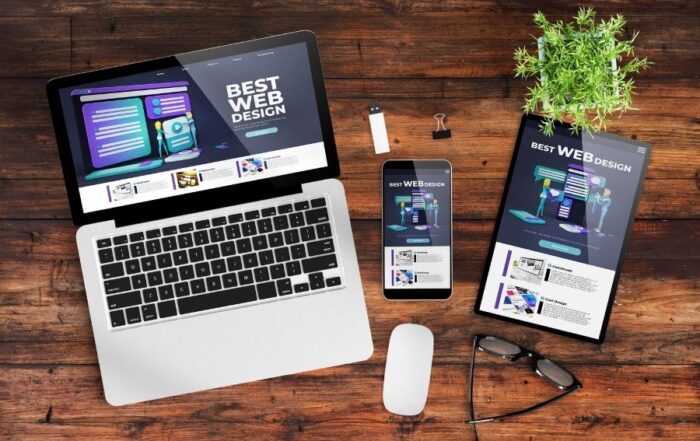
Top 10 Website Design Trends for 2025: Boost UX, SEO & Engagement with Bold New Styles
Web design in 2025 is going through a bit of a glow-up – and not just in the visual sense. It’s less about chasing the latest aesthetic trend and more about building smarter, more responsive experiences that greatly enhance user experience (UX). From how a website looks to how it feels to interact with, website design trends are telling us that right now it’s all about intentionality and genuine connection.
As web developers and designers, we’re excited about where we are headed with the latest website design trends for 2025. Continue reading to discover what we are seeing with regards to color, menus, focus on user experience, contact forms, and much more.
Block-Based Layouts and Vivid Contrast
Bold, block-based layouts with vibrant color contrasts are prominent, helping organize content visually and guide users naturally through the site. This approach is both visually striking and highly functional, making navigation intuitive and highlighting key information.
Minimalist and Streamlined Navigation
Menus are becoming simpler, with fewer items and less visual clutter. The focus is on essential links, clear hierarchy, and easy access, reducing cognitive overload for users. For larger sites, less essential pages are only accessible from a footer navigation menu, helping ensure streamlined top-page navigation for users.
Mega Menus and Dropdowns
Mega menus continue to dominate content-rich sites like e-commerce and news platforms. These menus are more visually appealing, with organized categories, icons or images, and subtle hover animations to prevent overwhelming users.
Experimental Navigation and Scrolling
Creative navigation patterns, such as experimental menus and scrolling effects (including parallax and storytelling scrolls), are gaining traction. These approaches make browsing more interactive and engaging.
Organic Shapes and Custom Illustrations
Organic, flowing shapes and custom illustrations add a unique, human touch to websites, differentiating brands and making sites more memorable while supporting storytelling.
Text-Only Hero Images
Minimalist hero sections using only text (no images) focus attention on messaging and brand identity, streamlining the user experience and reducing load times.
Smart Video and Data Visualization
Videos and dynamic data visualizations are used to communicate complex information quickly and accessibly, improving both visual appeal and user comprehension.
Macro and Micro Animations
Large-scale (macro) animations, such as animated headers and backgrounds, and subtle (micro) interactions, like button hovers and cursor effects, are widely used to guide users and add delight to the browsing experience without being distracting.
Mobile-First and Responsive Design
Prioritizing mobile-first layouts and accelerated mobile pages is essential, as over 60% of web traffic comes from mobile devices. Google’s mobile-first indexing further cements the need for seamless mobile experiences, making this a foundational trend for 2025.
Progressive Forms and Integrated Chatbots
Forms are smarter and more dynamic, enhancing user experience with a more interactive feel to the overall website experience. Progressive forms, also known as conditional forms, also greatly reduce human spam to contact forms, which provides better quality contact form responses for the website owner. Chatbots are also evolving into more conversational “chatbuds,” improving user support and self-service functionality.
While we appreciate the visual website design trends we are seeing this year, we are most excited that usability isn’t taking a backseat. In fact, user experience is becoming more nuanced than ever. A bold layout or unexpected color scheme might catch attention, but it’s the details – the invisible polish – that keep users engaged. Thoughtful micro-interactions, like a satisfying hover effect or an animation that responds to user behavior, add a layer of delight that turns passive browsing into active engagement.
These subtle moments can guide users, reinforce brand tone, and make the interface feel intuitive rather than mechanical. These aren’t gimmicks. They’re the building blocks of emotional connection – of trust. When a website feels like it’s responding to you in real time, it fosters a sense of flow, of being in sync with the experience.
Website Design Trends Are Evolving: Here’s What Comes Next
The bottom line?
Web design in 2025 is evolving into something more fluid, responsive, and human than ever before. The best sites don’t just look good. They feel good to use. They’re fast, flexible, and built with real people in mind. Whether you’re launching something new or rethinking your brand’s digital home, the focus this year (and honestly, moving forward) should be on experiences that connect, not just convert.
If that’s the kind of digital experience you’re ready to create, let’s talk. We’d love to help you bring it to life.




